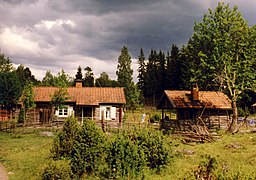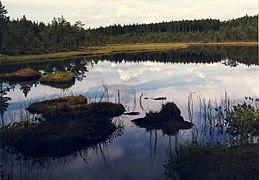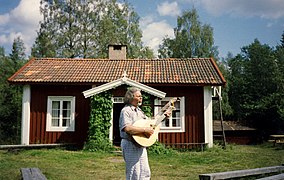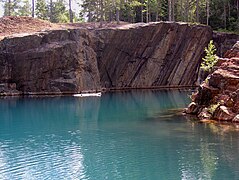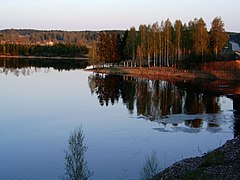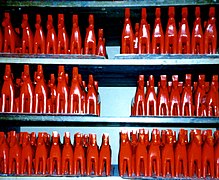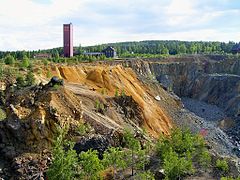Dalarna
| Dalarna | |
|---|---|

|

|
| Basic data | |
| Part of the country (landsdel) : | Svealand |
| Province (län) : | Dalarnas län , Gävleborgs län , Jämtlands län , Värmlands län |
| Surface: | 29,086 km² |
| Residents: | 277,354 (Dec. 31, 2013) |
| Population density: | 9 inhabitants per km² |
| Highest elevation: | Storvätteshågna 1204 m ö.h. |
| Largest lake: | Siljan 280 km² |
[ ˈdɑːˌlɑːɳa ] (Dalekarlien) is ahistorical province(Swedish landskap) in the heart ofSweden. The boundaries roughly coincide with those of today's Dalarnaprovince.
Dalarna means “the valleys”, which refers to the wooded, hilly landscape around Lake Siljan and the Dalälven . The residents of Dalarna - the Dalkarlar or Masar (male) and Dalkullor (female) - speak the Dalmål dialect .
Dalarna is characterized by the wood industry, the central regions benefit from tourism within Sweden. A typical event in the region is the Wasalauf , a cross-country ski run from Sälen to Mora .
geography
The central locations are the industrial towns of Borlänge and Falun ; the latter is also known for its copper mine and the hosting of winter sports competitions. The south of Dalarna belongs to the historic Bergslagen mining area .
The tourist center of the region, however, is the Siljansee , located in the midst of an idyllic rural setting , with the larger towns of Leksand , Rättvik and Mora , all of which are on the banks of the lake. The west of Dalarna is dominated by fells and popular winter sports centers such as Sälen and Idre , which is the second largest in Sweden after Åre , where Swedish ski championships are held from time to time. North of the Siljan extends Orsa Finnmark , a barely inhabited, remote forest region whose name the once settled there Forest Finns recalls.
history
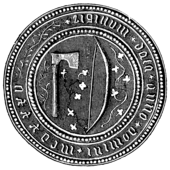
Dalarna is first mentioned in 1177 in the Sverresaga , where the province of Järnbäraland ("iron-bearing land") is mentioned, an indication of the early mining activities. Dalarna is described as a pagan land subject to the king of the Svear .
In the 15th and 16th centuries, Dalarna was the stronghold of anti-Danish national consciousness in Sweden. From here, the Engelbrekt uprising, directed against the union with Denmark, spread across Sweden until 1436. Imperial Regent Karl Knutsson Bonde had Engelbrekt murdered, but he also relied on the "Dalekarle" from Dalarna in the internal Swedish power struggles and disputes with Denmark. During the Danish-Swedish Wars of 1468/69, 1470/71 and 1497–1500 , the free peasant warriors from Dalarna formed the backbone of the armies of the imperial administrators Sten Sture and Svante Sture , and at the beginning of the Swedish War of Liberation (1520–1523) Gustav I fled Wasa before the Danes to Dalarna, where he was able to persuade the traditionally rebellious population to fight against foreign rule. With the fighters from Dalarna, he finally succeeded in driving the Danes out and was elected King of Sweden. In memory of an episode of these events, the Vasa Run takes place every year today . Between 1524 and 1534, the traditionally rebellious "Dalekarlier" rose up in several uprisings against Gustav I. Wasa. Once again, in 1743, they rose up against the landowners and the aristocratic factions ruling in Stockholm, but from 1788–1790 they supported King Gustav III. in the fight against Russians, Danes and the intrigues of the nobility.
coat of arms
Description: In blue two golden crossed arrows with silver tips, over which a golden crown hovers.
regional customs
There is a lively cultivation of customs in Dalarna, e.g. B. There are many regional variants of the traditional costume that is worn on special occasions such as the raising of the Majstång at Midsommar .
The costume of Dalarna looks like this: Both sexes have long hair that hangs down over the shoulders. The men wear a low, round hat with a broad brim, white or blue overskirts, blue stockings and shoes, and in winter furs; Women and girls white linen jackets and bonnets, white standing collars, colored woolen aprons and red woolen stockings. The shoes have high heels and mostly birch bark soles.
The folk music is of great importance; Every year a national folk music festival Musik vid Siljan takes place in Rättvik .
Dalarna is also a center of folkloric handicrafts. In Nusnäs made dalecarlian horse (Dalahästar) are now a symbol of Sweden. The typical red color of the Swedish wooden houses, the Falu rödfärg , also comes from Dalarna.
In the region around Älvdalen in northwestern Dalarna a local language variant that exists Älvdalische that has many ancient features.
Arts and Culture
Numerous Swedish artists come from Dalarna. The most popular is undoubtedly the painter Carl Larsson (1853–1919); his Sundborn artists' home is now a museum. Carl Larsson's colleague and friend was Anders Zorn (1860–1920), and his home in Mora can also be visited.
The poet Erik Axel Karlfeldt (1864–1931) was best known for his homeland-related romantic poems, some of which were also popular as songs. The Karlfeldtsgården (also Tolvmansgården ) near Avesta is also a museum.
The working-class poet and lyric poet Dan Andersson (1888–1920) became known not far beyond the borders of Sweden . In August every year he is honored with a Dan Andersson Week in Ludvika .
A famous son of the province is Borlange- born opera tenor Jussi Björling (1911–1960), one of the most important singers of the 20th century. He is still very popular even half a century after his death. Even Henning Mankell's commissioner Wallander likes to listen to old recordings by the artist.
Selma Lagerlöf's novel Anna Svärd (German: Anna, the girl from Dalarne ) describes the life of the men and women from Dalarna who drove their lives as peddlers in Sweden in the 19th century. It is the third part of a trilogy of novels that appeared between 1925 and 1928 and tells of the fate of the fictional Löwensköld family. Selma Lagerlöf's novel Jerusalem is also largely set in Dalarna and is about the life of the farmers there.
The film Back to Dalarna! (S 2004) by Maria Blom is set largely in Dalarna and was shot near Rättvik . It addresses the slow and steady migration of parts of the population from rural areas to urban centers, especially to Stockholm .
The open-air theater Dalhalla was built in an old limestone quarry near Rättvik in 1993 . The theater now holds 4,000 spectators. Classical and modern music events are presented in the summer.
The Swedish indie rock band Mando Diao comes from Borlänge and named one of their songs after the landscape.
Landscape symbols
The following are considered "landscape symbols":
- Flower: meadow bellflower and round-leaved bellflower
- Animal: eagle owl
- Fish: minnow
- Fungus: sand boletus
- Stone: porphyry
Others
The oldest tree in the world - according to carbon-14 dating - is the Old Tjikko spruce in Fulufjäll in Dalarna , at 9550 years old .
photos
Dan Andersson's Luossastugan
Ladies Vasaloppet 2006
Falu koppargruva Stora kill
Old Tjikko (oldest tree in the world)
Web links
- Information about Dalarna on visitdalarna.se (German)
- Images Dalarna on destination-alvdalen.se (Swedish)
Individual evidence
- ↑ Statistiska centralbyrån: Folkmängd i landskapen on December 31, 2013
- ↑ Swedish spruce has lived for 9550 years. In: dpa. April 17, 2008, accessed October 17, 2009 .

